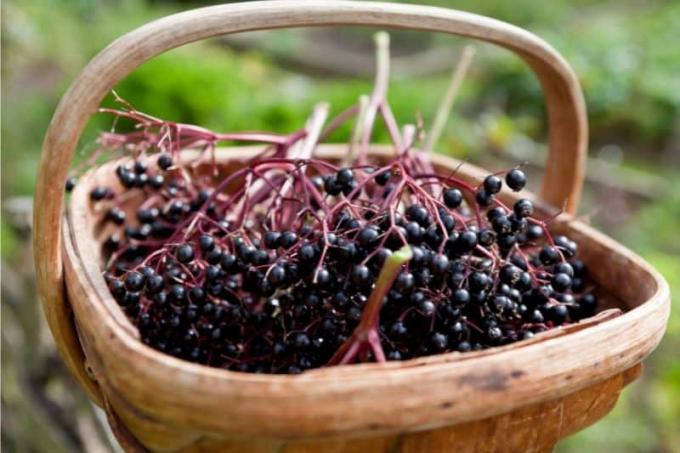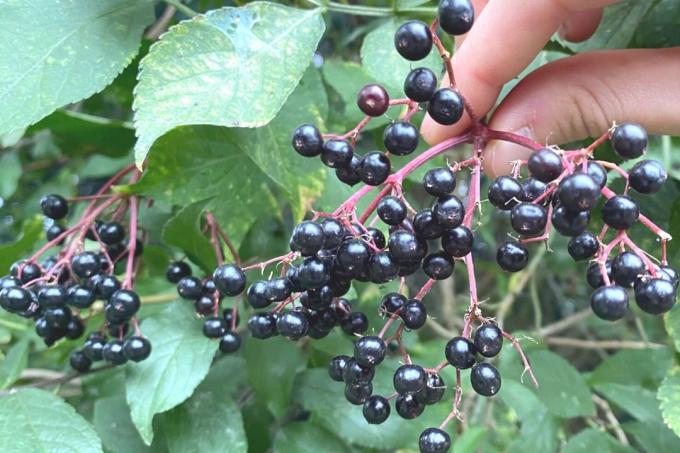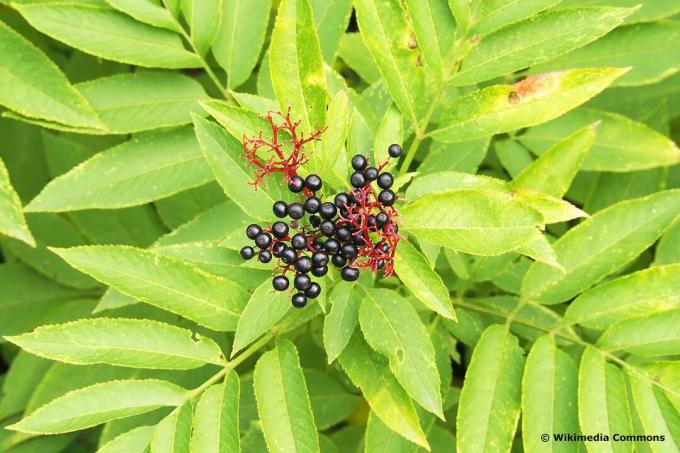
When it comes to elderberries, the right harvest time is important. You must not harvest the fruits too early, but also not too late. You can find out everything you need to know about this in this article.
In a nutshell
- Harvest time from August to September/October
- Timing dependent on weather
- ripe berries are plump, glossy and dark in color
- slight confusion with poisonous dwarf elder possible
- Elderberries are poisonous when raw
Table of contents
- Harvest time of elderberries
- Identify ripe berries
- risk of confusion
- frequently asked Questions
Harvest time of elderberries
When the fruit branches of the elder (Sambucus) with the umbrella-shaped cymes slowly descend to the ground and blackbirds flock to the elder bush, is the time to harvest the elderberries came. It depends primarily on the weather and varies from region to region. Normally, the harvest period for elderberries extends from August to the end of September/beginning of October. The harvest ends at the latest when the elder sheds its leaves in autumn, because the remaining ones fall at the same time
inflorescences from the branches. About 15 to 20 kilograms of fruit can be harvested per bush. There are small differences in the ripening time of the wild form of black elder (Sambucus nigra) and the cultivated varieties:- Black elderberries ripen in stages
- in cultivars ripening of the berries at the same time as
- "Haschberg" variety from the beginning to the middle of September
- Variety "Mammut" from the end of August
- Varieties "Samdal", "Samyl", "Sampo", "Riese from Vossloch" from mid-August

A notice: The berries are not picked individually, but the entire umbel is cut off the branch with scissors.
Identify ripe berries
Harvest the umbels with their individual berries only when the fruits are really ripe. You must remove unripe and spoiled fruit. You can recognize ripe elderberries that herald the harvest time by these characteristics:
- completely colored
- Individual berries plump and shiny
- burst open quickly
- Black elderberry: deep dark colored black to violet berries without reddish spots
- Red elder (Sambucus racemosa): complete red coloring of the berries with no green areas

If the berries are dull in color and slightly dried out, then they are already overripe. Such fruit umbels can get stuck on the tree. The birds are happy about it.
A notice: In May to June, flower umbels can be used to make elderberry syrup or for drying tea to be harvested.
risk of confusion
The black elder can easily be confused with the dwarf elder (Sambucus ebulus), also known as the parakeet. The entire shrub, including its fruit, is poisonous to humans. Therefore, the berries must not be eaten under any circumstances.

The dwarf elder can be recognized by the following characteristics:
- white pith in the branches
- grooved stems
- herbaceous growth, no woody growth
- maximum growth height 150 cm
- 7 to 9 imparipinnate leaves
- small dents on the black, unpleasant-smelling fruits
- erect umbels of flowers
frequently asked Questions
The black berries are rich in minerals such as potassium and calcium and also contain a large amount of vitamins A, B and C. These ingredients strengthen the immune system and make the body less susceptible to diseases. Elderberry juices and teas help with colds and fever. They have a diuretic, diaphoretic and expectorant effect. Cooked elderberries cleanse the blood, stomach and kidneys. In addition, muscle building and heart health are supported.
No. Raw ripe and green fruits, as well as stone pits are slightly toxic. They contain the poison sambunigrin. After consumption, vomiting, nausea and diarrhea may occur. Therefore, the berries should only be processed into juices and jams, among other things. The poison only breaks down when the fruit is cooked. The cooking time should be at least 15 minutes. However, heating for 20 to 30 minutes is better. The flowers, on the other hand, can be eaten raw.
Ripe elderberries will keep for three to four days at room temperature. Many ingredients are lost during longer storage, so the berries should be processed at least two to four hours after harvesting. If this is not possible, storage in the refrigerator is appropriate. The shelf life here is up to two weeks. Storage takes place in flat trays covered with foil. Elderberries can also be frozen for 10 to 12 months.



